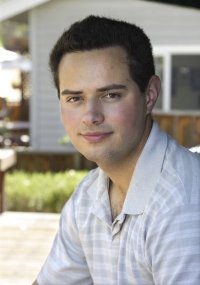Victor Quintanar-Zilinskas: Difference between revisions
From Santa Fe Institute Events Wiki
No edit summary |
No edit summary |
||
| Line 5: | Line 5: | ||
Victor intends for his research focus to, in the near future, shift to the study of the following two phenomena. First, the working brain frequently witnesses the self-organization of brief episodes of synchronization between groups of neurons; this has an impact on information processing (e.g. in the context of decision-making). Second, complex dynamics generate information (Turing patterns are an illustration of this idea); information emergent from the dynamics of a brain-like system is of great potential cognitive utility. [http://www.ics.uci.edu/~welling/publications/papers/herding_icml09_final.pdf Modeling] and [http://www.jneurosci.org/content/30/27/9017.abstract EEG analysis] results suggest the possibility that probability inferences and information that is fundamentally an interpretation of (rather than intrinsic to) sensory input (e.g. odorant toxicity), respectively, can be emergence products of the brain's dynamics. | Victor intends for his research focus to, in the near future, shift to the study of the following two phenomena. First, the working brain frequently witnesses the self-organization of brief episodes of synchronization between groups of neurons; this has an impact on information processing (e.g. in the context of decision-making). Second, complex dynamics generate information (Turing patterns are an illustration of this idea); information emergent from the dynamics of a brain-like system is of great potential cognitive utility. [http://www.ics.uci.edu/~welling/publications/papers/herding_icml09_final.pdf Modeling] and [http://www.jneurosci.org/content/30/27/9017.abstract EEG analysis] results suggest the possibility that probability inferences and information that is fundamentally an interpretation of (rather than intrinsic to) sensory input (e.g. odorant toxicity), respectively, can be emergence products of the brain's dynamics. | ||
Victor was raised in [http://en.wikipedia.org/wiki/Palo_Alto,_California Palo Alto, CA] and his interests and outlooks are heavily influenced by his upbringing in [http://en.wikipedia.org/wiki/Silicon_Valley Silicon Valley's] technoculture. He double-majored in math and biology at [http://en.wikipedia.org/wiki/Santa_Clara_University Santa Clara University] (class of 2009), where he did his first computational neuroscience research, engendering his current interests. He also worked with [http://www.sis.pitt.edu/~gbowker/ Geoffrey Bowker] (who was, at the time, at [http://en.wikipedia.org/wiki/Santa_Clara_University Santa Clara University]) to characterize the work practices of scholar communities that study complex systems (e.g. networks of ecologists that study various facets of the same ecosystem) and explain them in the context of the historical trajectory of scientific understanding of the systems under study. The study's conclusion, which will be appreciated by but unsurprising to this page's [http://en.wikipedia.org/wiki/Santa_Fe_Institute SFI]-affiliated readers, was that the increasing temporal resolution of data is encouraging a shift from the study of system processes to the study of salient events (e.g. shifts between stable states of the composition of an ocean bacteria population; large storms). Victor's current "applied philosophy" interest is the connections between [http://en.wikipedia.org/wiki/Constructivism Constructivism], creativity theory, and interdisciplinarity--especially when the interdisciplinarity is a consequence of the study of a complex/systems phenomenon. | Victor was raised in [http://en.wikipedia.org/wiki/Palo_Alto,_California Palo Alto, CA] and his interests and outlooks are heavily influenced by his upbringing in [http://en.wikipedia.org/wiki/Silicon_Valley Silicon Valley's] technoculture. He double-majored in math and biology at [http://en.wikipedia.org/wiki/Santa_Clara_University Santa Clara University] (class of 2009), where he did his first computational neuroscience research, engendering his current interests. He also worked with [http://www.sis.pitt.edu/~gbowker/ Geoffrey Bowker] (who was, at the time, at [http://en.wikipedia.org/wiki/Santa_Clara_University Santa Clara University]) to characterize the work practices of scholar communities that study complex systems (e.g. networks of ecologists that study various facets of the same ecosystem) and explain them in the context of the historical trajectory of scientific understanding of the systems under study. The study's conclusion, which will be appreciated by but unsurprising to this page's [http://en.wikipedia.org/wiki/Santa_Fe_Institute SFI]-affiliated readers, was that the increasing temporal resolution of data is encouraging a shift from the study of system processes to the study of salient events (e.g. shifts between stable states of the composition of an ocean bacteria population; large storms). Victor's current "applied philosophy" interest is the connections between [http://en.wikipedia.org/wiki/Constructivism Constructivism], creativity theory, and interdisciplinarity--especially when the interdisciplinarity is a consequence of the study of a complex/systems phenomenon. Currently, few dispute the intuition that arriving at an understanding of a complex phenomenon can involve some conceptual creativity that crosses traditional disciplinary bounds--but, this idea currently lacks the kind of philosophical crystallization that 1) would reveal various corollaries 2) enable its explicit application in scientific and educational practice. | ||
Revision as of 02:11, 17 March 2011
Victor Quintanar-Zilinskas is a graduate student at the University of California, Irvine. His current research focus is the emergence of system-level information processing properties of many-neuron (on the order of 1000s) networks; he also studies the systems biology of transcription factor gradient maintenance over long distances.
Victor intends for his research focus to, in the near future, shift to the study of the following two phenomena. First, the working brain frequently witnesses the self-organization of brief episodes of synchronization between groups of neurons; this has an impact on information processing (e.g. in the context of decision-making). Second, complex dynamics generate information (Turing patterns are an illustration of this idea); information emergent from the dynamics of a brain-like system is of great potential cognitive utility. Modeling and EEG analysis results suggest the possibility that probability inferences and information that is fundamentally an interpretation of (rather than intrinsic to) sensory input (e.g. odorant toxicity), respectively, can be emergence products of the brain's dynamics.
Victor was raised in Palo Alto, CA and his interests and outlooks are heavily influenced by his upbringing in Silicon Valley's technoculture. He double-majored in math and biology at Santa Clara University (class of 2009), where he did his first computational neuroscience research, engendering his current interests. He also worked with Geoffrey Bowker (who was, at the time, at Santa Clara University) to characterize the work practices of scholar communities that study complex systems (e.g. networks of ecologists that study various facets of the same ecosystem) and explain them in the context of the historical trajectory of scientific understanding of the systems under study. The study's conclusion, which will be appreciated by but unsurprising to this page's SFI-affiliated readers, was that the increasing temporal resolution of data is encouraging a shift from the study of system processes to the study of salient events (e.g. shifts between stable states of the composition of an ocean bacteria population; large storms). Victor's current "applied philosophy" interest is the connections between Constructivism, creativity theory, and interdisciplinarity--especially when the interdisciplinarity is a consequence of the study of a complex/systems phenomenon. Currently, few dispute the intuition that arriving at an understanding of a complex phenomenon can involve some conceptual creativity that crosses traditional disciplinary bounds--but, this idea currently lacks the kind of philosophical crystallization that 1) would reveal various corollaries 2) enable its explicit application in scientific and educational practice.

